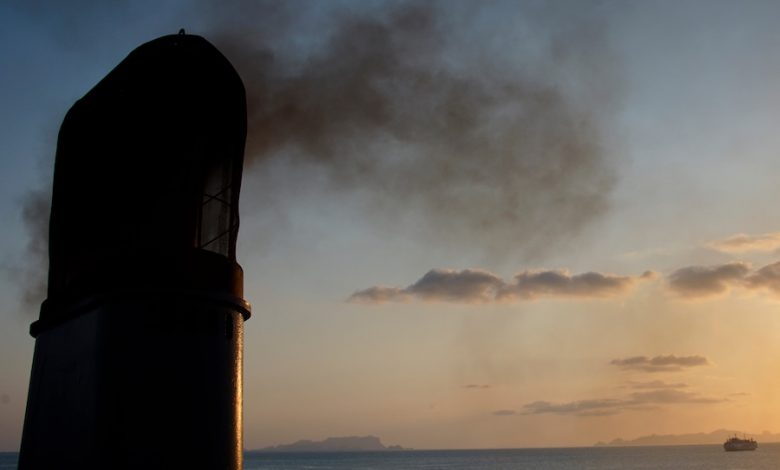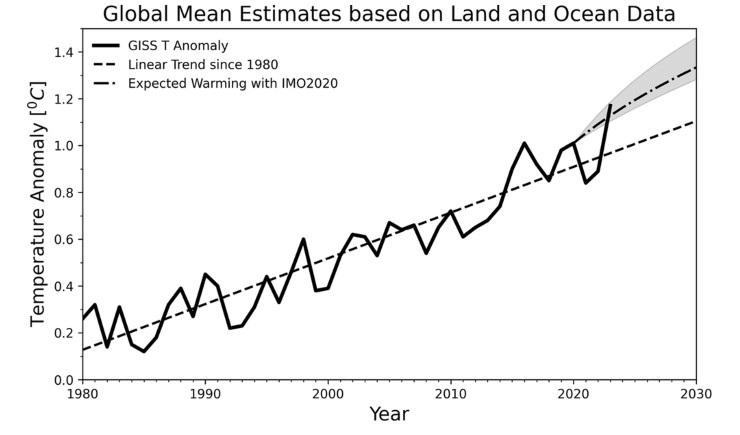Study suggests global sulphur cap has contributed to climate crisis

Several US scientists have claimed in a paper published this week that a rule imposed by the International Maritime Organization in 2020 could have increased global temperatures, explaining last year’s high temperatures.
The IMO 2020 fuel regulations, also known as the global sulphur cap, abruptly reduced the emission of sulfur dioxide from international shipping from 3.5% to 0.5%. This 80% drop, according to scientists from Maryland and Washington, created an inadvertent so-called geoengineering termination shock with a global impact.
The warming effect of anthropogenic greenhouse gases has been partially balanced by the cooling effect of anthropogenic aerosols. The IMO2020 rule was intended to benefit public health by decreasing aerosol loading, but this aerosol decrease can temporarily accelerate global warming by dimming clouds across the global oceans.
The regulations took effect quickly and the scientists argue in the paper that it had a termination shock through marine cloud dimming and reducing cloud droplet concentration. More recent studies show that aerosols can also change liquid water paths and total cloud fraction, which also greatly affect the amount of solar radiation reflected by clouds
The scientists claim that ship tracking data suggests that IMO2020 reduced the occurrence and modified the properties of ship tracks across global oceans, demonstrating that a regulation intended to reduce pollution had collateral effects on cloud microphysics.
The researchers calculate the drop increased the amount of solar energy heating the oceans by between 0.1 and 0.3 watts per square metre, around double that of some earlier estimates. This effect was more acute in areas of the ocean with lots of shipping activity such as the North Atlantic, which has been anomalously hot since last year and, according to the study, experienced a warming influence more than triple the average.
The researchers added that this warming influence, known as ‘radiative forcing’, would change global temperatures, using a simplified climate model that leaves out the influence of the deep ocean.
This paper follows research done by Michael Diamond, an atmospheric scientist at Florida State University, in 2023 who claimed that the lack of ship tracks warmed the planet up faster and the trend is magnified in the Atlantic, where maritime traffic is particularly dense. In shipping corridors, the increased light represents a 50% boost to the warming effect of human carbon emissions.
The 2020 regulations change translated to an additional rise of about 0.16°C in global average temperatures in the seven years after emissions dropped, effectively doubling the rate of warming during that period compared with previous decades.
The scientists calculated the ratio between the aerosol optical depth change due to IMO2020 and that between pre-industrial and present-day. Over most of the ocean, the ratio is smaller than 10% because of sparse shipping outside the major shipping routes.
Over the North Pacific and North Atlantic, on the other hand, it can exceed 10% and reach 25% in the Norwegian Sea and off the western European and northwestern African coasts.
In these regions, the total anthropogenic aerosol concentration is relatively low because of declining emissions of aerosols and their precursors since the 1980s, making ship-emitted aerosols an important component of the anthropogenic maritime aerosols.
These calculations are somewhat confirmed by data from the EU’s Copernicus Climate Change Service. It stated last year that the average temperature of the global ocean surface on July 31 was exactly 20.9648 degrees Celsius, narrowly beating the previous record set in 2016. The Atlantic Ocean’s surface temperature however surged to a record 25°C, a whole 1°C warmer than the previous high, set in 2020.


I would love to see whenever there was a new article about scientific discoveries, the scientists source of funding is also mentioned.
Always follow the money.
“Always follow the money.” Yes, and maybe the FF industries should not receive the trillions of dollars they receive annually in taxpayer funded subsidies.
Grown-ups tend to check the scientific publications before pushing long debunked conspiracy theories, don’t they. When they do they find there were a number of authors and institutions involved including Goddard Space Flight Center. GSFC is a major US laboratory for developing and operating uncrewed scientific spacecraft. GSFC conducts scientific investigation, development, manufacturing and operation of space systems, and development of related technologies.
And so on.
Always follow the money. Yes, to the $trllions we subsidise fossil fuels.
Ten of the authors are from the Sciences and Exploration Directorate, Goddard Space Flight Center, Greenbelt, MD, USA. So USA taxpayer funded.
“However, it does suggest that Marine cloud brightening (MCB) is a viable solar radiation modification scheme in temporarily slowing the rate of climate warming”
These “scientists” are finding whatever their paymasters tell them to find. There is no climate crisis. The climate has been changing for billions of years. Just another excuse for another tax.
“These “scientists” are finding whatever their paymasters tell them to find. There is no climate crisis. The climate has been changing for billions of years.”
The climate has indeed been changing for billions of years, and how do you know that? From the scientists you denigrate.
Conclusion. Your tinfoil need replacing.
“Just another excuse for another tax.” I note you are blissfully unaware of the £$€¥₨ trillions taxpayers annually subsidise the fossil fuel industry. But then conspiracy theorists reject everything that doesn’t fit the fantasy they want to believe.
“The climate has been changing for billions of years” Correct..How do we know that? “These “scientists” are” how.
“Just another excuse for another tax. No. What about the £$€¥₨ trillions taxpayer subsidies fossil fuel interests receive annually?
It would be more respectful to both the scientist(s) who authored this study as well as to the readers of this publication if Prof. Lepic would refer to the actual study by DOI or at least by title.
It should go without saying that these scientists also have names. Perhaps give credit by actually naming them ?
So that we, as readers, can find the actual study.
I mean your explanation is very well written and clear, for which, thank you.
But it should, just for courtesy, at least mention the name of the original publication and author, in my opinion.
Especially as, after digging, I found that it has apparently been published in an open access format.
Available here: https://www.nature.com/articles/s43247-024-01442-3 Author: Tianle Yuan
Thanks
An all to common fault, however finding the paper is child’s play. Over the years I have found naysayers almost invariably neglect to access linked papers.
If the ‘trend’ between 1980 and 2020 is related to the GISS T anomaly, it is not linear at all, rendering the whole meticulous study (or the conclusions at least) pointless.
Wrong.
“The climate has been changing for billions of years” Correct..How do we know that? “These “scientists” are” how.
“Just another excuse for another tax. No. What about the £$€¥₨ trillions taxpayer subsidies fossil fuel interests receive annually?